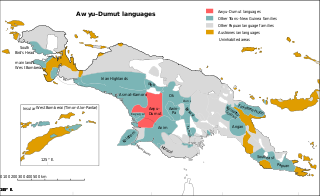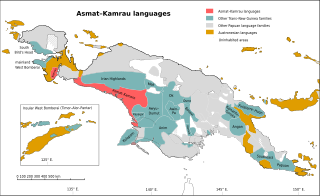Related Research Articles

The Papuan languages are the non-Austronesian and non-Australian languages spoken on the western Pacific island of New Guinea, as well as neighbouring islands in Indonesia, Papua New Guinea, Solomon Islands, and East Timor by around 4 million people. It is a strictly geographical grouping, and does not imply a genetic relationship.

The West Papuan languages are a proposed language family of about two dozen non-Austronesian languages of the Bird's Head Peninsula of far western New Guinea, the island of Halmahera and its vicinity, spoken by about 220,000 people in all. It is not established if they constitute a proper linguistic family or an areal network of genetically unrelated families.
The Kwomtari–Fas languages, often referred to ambiguously as Kwomtari, are an apparently spurious language family proposal of six languages spoken by some 4,000 people in the north of Papua New Guinea, near the border with Indonesia. The term "Kwomtari languages" can also refer to one of the established families that makes up this proposal.

Stephen Adolphe Wurm was a Hungarian-born Australian linguist.

Western Pantar, sometimes referred to by the name of one of its dialects, Lamma, is a Papuan language spoken in the western part of Pantar island in the Alor archipelago of Indonesia. Western Pantar is spoken widely in the region by about 10,000 speakers. Although speakers often use Malay in political, religious, and educational contexts, Western Pantar remains the first language of children of the region, and is acquired to some extent by immigrants.
Arthur Capell was an Australian linguist, who made major contributions to the study of Australian languages, Austronesian languages and Papuan languages.

The Greater Awyu or Digul River languages, known in earlier classifications with more limited scope as Awyu–Dumut (Awyu–Ndumut), are a family of perhaps a dozen Trans–New Guinea languages spoken in eastern West Papua in the region of the Digul River. Six of the languages are sufficiently attested for a basic description; it is not clear how many of the additional names may be separate languages.

The Asmat – Kamrau Bay languages are a family of a dozen Trans–New Guinea languages spoken by the Asmat and related peoples in southern Western New Guinea. They are believed to be a recent expansion along the south coast, as they are all closely related, and there is little differentiation in their pronouns.

The Mek languages are a well established family of Papuan languages spoken by the Mek peoples. They form a branch of the Trans–New Guinea languages (TNG) in the classifications of Stephen Wurm (1975) and of Malcolm Ross (2005).
The Dani or Baliem Valley languages are a family of clearly related Trans–New Guinea languages spoken by the Dani and related peoples in the Baliem Valley in the Highland Papua, Indonesia. Foley (2003) considers their TNG status to be established. They may be most closely related to the languages of Paniai Lakes, but this is not yet clear. Capell (1962) had posited that their closest relatives were the Kwerba languages, which Ross (2005) rejects.

The Duna–Pogaya (Duna–Bogaia) languages are a proposed small family of Trans–New Guinea languages in the classification of Voorhoeve (1975), Ross (2005) and Usher (2018), consisting of two languages, Duna and Bogaya, which in turn form a branch of the larger Trans–New Guinea family. Glottolog, which is based largely on Usher, however finds the connections between the two languages to be tenuous, and the connection to TNG unconvincing.

The Kamula–Elevala languages are a small family of the Trans–New Guinea languages spoken in the region of the Elevala River.

The Gogodala–Suki or Suki – Aramia River languages are a small language family of Papua New Guinea, spoken in the region of the Aramia River.

The Mombum languages, also known as the Komolom or Muli Strait languages, are a pair of Trans–New Guinea languages, Mombum (Komolom) and Koneraw, spoken on Komolom Island just off Yos Sudarso Island, and on the southern coast of Yos Sudarso Island, respectively, on the southern coast of New Guinea. Komolom Island is at the southern end of the Muli Strait.

The East Strickland or Strickland River languages are a family of Papuan languages.
Momuna (Momina), also known as Somahai, is a Papuan language spoken in Yahukimo Regency, Highland Papua and Asmat Regency, South Papua, Indonesia.
The Dani–Kwerba languages were a hypothetical language family proposed by Arthur Capell in 1962 and adopted by Stephen Wurm as part of his Trans–New Guinea (TNG) phylum. Malcolm Ross reassigned the Dani languages to a West Trans–New Guinea linkage and the Kwerba languages to his Tor–Kwerba family, outside of TNG altogether.
Suki is a Gogodala-Suki language spoken by about 3500 people several miles inland along the Fly River in southwestern Papua New Guinea.
West Bird's Head languages are a small family of poorly documented Papuan languages spoken on the Bird's Head Peninsula of New Guinea.
Duriankari, or Duriankere, is a possibly extinct Papuan language of Indonesian Papua. It is associated with the village of Duriankari at the southern tip of the island of Salawati, which is part of the Raja Ampat Archipelago and is adjacent to the Bird's Head Peninsula of the West Papuan mainland.
References
- ↑ Gogodala at Ethnologue (18th ed., 2015) (subscription required)
- Capell, Arthur. 1969. A Survey of New Guinea Languages. Sydney: University of Sydney.
- Voorhoeve, C.L., 1970. Some notes on the Suki-Gogodala subgroup of the Central and South New Guinea phylum. In S. A. Wurm & D. C. Laycock, eds. Pacific Linguistic Studies in honour of Arthur Capell. Canberra: Pacific Linguistics.
- Voorhoeve, C. L., 1975. Central and Western Trans-New Guinea Phylum Languages. In Stephen A. Wurm (ed.), New Guinea Area Languages and Language Study Vol 1: Papuan Languages and the New Guinea linguistic scene, 345-460. Canberra: Research School of Pacific and Asian Studies, Australian National University.